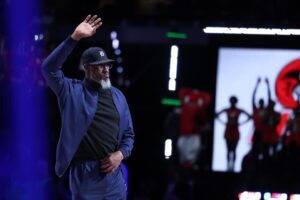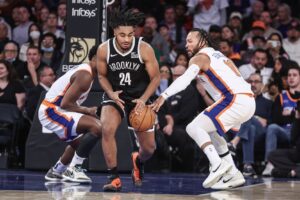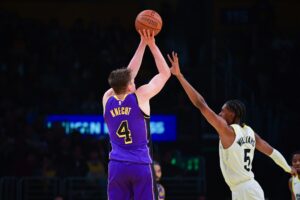Exhale everyone. We made it. A national champion was crowned on Monday night, and a full NCAA Tournament took place, sans one game (more on that later). Hope sprang eternal when college football was able to complete a season, even with its own ups and downs. The road was long, and it took a lot of commitment and sacrifices from many, but the season reached the finish line. This is an amazing feat that requires the thanks of medical staff, players, coaches, and everyone else in between. Keep that in mind as we do our college basketball season in review.
College Basketball Season in Review
November
Perhaps it was just the impending winter weather, but things looked bleak at the start. The Ivy League opted out of the season entirely, along with MEAC programs Bethune-Cookman and UMES. Numerous teams were going on pause, and keeping up with Jon Rothstein’s COVID pause tracker became a daily routine. Bubble events saw many scheduling shuffles, but ultimately many were still able to go on. It felt as though a college basketball season in review might not even be plausible. However, while the season started a little over two weeks later than expected, the ball still tipped on November 25th.
Opening week saw the madness return like it never left. San Diego State knocked off a ranked UCLA team. Georgia State and Georgia Tech played four overtimes. San Francisco held on to topple a top-five team in Virginia. Furthermore, the trend of numerous mid-majors losing to non-Division I teams took off as well. This should’ve been a sign of things to come. Kansas ended the month setting a new record as they were ranked in the AP Poll for the 222nd consecutive week. It was little consolation for their opening game loss to the poll’s top team in Gonzaga.
FINAL: San Francisco 61, No. 4 Virginia 60
We have our first big top-25 upset of the season. The Dons lost their opener to UMass-Lowell; two days later, they take down top-five Virginia. What a win.
— Jeff Borzello (@jeffborzello) November 27, 2020
December
For all the excitement of a new season, we were quickly reminded that there was still a pandemic happening. That should’ve been obvious as numerous postponements and cancellations were happening. However, it didn’t truly set in for many fans until the top two teams in Gonzaga and Baylor had to call off their match-up on December 5th.
Things only got scarier when Keyontae Johnson of Florida collapsed in their game against Florida State on December 12th. Thankfully, Johnson has been well on his way to recovery since then. However, this incident prompted many to immediately wonder if COVID was to blame. Doctors later revealed it wasn’t, but it still felt like an omen that maybe pressing forward wasn’t a great idea.
Duke made news as well, with Coach Mike Krzyzewski announcing that the Blue Devils would not continue their non-conference schedule due to COVID concerns. There were many who believed this was partly done due to Duke’s unusually poor start, but you can’t blame a coach for being concerned for the health and well-being of his players.
The month wasn’t all doom and gloom though, unless you’re a Kansas State fan. The Wildcats lost to Division II Fort Hays State, becoming the first power team to lose at home to a non-DI opponent for the first time in 20 years. Illinois State had 57 assists and shot 83.4 percent from the field in a 177-108 victory over non-DI Greenville, both Division I records. Ohio set its own record, going on a 40-0 run in a 101-46 rout of Cleveland State. It was hard to believe at the time that both teams would be playing in the NCAA Tournament.
We went on a 40-0 run that spanned 12:47.
That was the largest run against another DI opponent in NCAA history. #OUohyeah pic.twitter.com/F6uxRrh5N2
— Ohio Men’s Basketball (@OhioMBasketball) December 6, 2020
January
The month of January saw a few surprise teams announce themselves. Michigan and Alabama didn’t have the highest of expectations, but both made it clear in January that they were ready for the spotlight. The Wolverines became the first team in Division I history to beat three straight top 25 teams by at least 19 points. They knocked off ranked Northwestern, Minnesota, and Wisconsin at the beginning of the month. Meanwhile, Alabama caught fire from beyond the arc. They drained 15 threes in a 31-point win over Arkansas and then hit 23 more in a 30-point rout of LSU one game later. It became the calling card for the Crimson Tide as they cruised to an SEC title.
While those teams were ascending, Duke, Kentucky, and North Carolina weren’t. We got more AP Poll history, as all three programs failed to appear in it at the same time for the first time since 1961. It was a sign of things to come as only North Carolina ended up dancing in March.
Out in California, UC Davis went 49 days without playing a game. The Aggies were forced to cancel many Big West games as local COVID ordinances prevented them from playing their scheduled games. Meanwhile, the Patriot League became the last league to tip-off conference play. Even with the delayed schedule, Loyola of Maryland and American still had to take COVID pauses right away, playing their first games of the season on January 16th.
All eyes also started to shift to the remaining unbeaten teams. The most unlikely of that group was Winthrop, who had rolled through their non-conference slate and the Big South. That all ended, however, against UNC Asheville on January 29th. It was the only loss the Eagles would suffer before the NCAA Tournament.
Today's poll is the 1,213th in AP history and just the 14th time that Duke, Kentucky and North Carolina are all unranked.
The last time that happened was on Dec. 18, 1961 – when only 10 teams were included in the AP Poll each week. pic.twitter.com/OZ8pRtnCie
— ESPN Stats & Info (@ESPNStatsInfo) January 18, 2021
February
The college basketball season in review saw a major upset right away in February. East Carolina stunned fifth-ranked Houston for their first win against a top-five team in program history. This was one of the more head-scratching losses of the season for any ranked team and one that contributed to Houston not winning the AAC regular-season title.
Meanwhile, Kansas joined their blue blood brothers for one week as they fell out of the AP Poll, ending the record they had just set in November at 231 consecutive weeks. The Jayhawks didn’t reel for long though, as they would become the first team to topple Baylor on the season later in the month.
Roy Williams became the fourth coach in men’s Division I history to reach the 900 career wins milestone. Williams accomplished this feat in fewer games and seasons than any other coach to achieve it. He would add just three more to his career accolades before announcing his retirement on April 1.
One under-the-radar news piece from February was the America East’s decision to schedule conference games on a week-by-week basis. This came after multiple teams had to pause due to COVID as well as Maine opting out of the remainder of the season for the same reason.
Finally, as March neared, we got a glimpse into what the tournament would truly look like. We knew a bubble was happening in Indianapolis, but we didn’t know what would happen in a worst-case scenario. That changed late in the month. The NCAA announced that no changes would be made to the bracket after it was revealed and that teams would not be replaced once we were 48 hours out from the Selection Show.
𝐋𝐈𝐕𝐈𝐍𝐆 𝐋𝐄𝐆𝐄𝐍𝐃. 🙌
Congratulations Coach Williams on 900 career head coaching wins.#CarolinaFamily pic.twitter.com/mfiXCAaAby
— Carolina Basketball (@UNC_Basketball) February 27, 2021
March
The most exciting month of the season caused everyone to hold their breath once again. Duke, Kansas, and Virginia all had to withdraw from their conference tournaments due to COVID protocols, just a few days out from Selection Sunday. Many wondered if all the hard work put into getting the season played would be for naught due to potential outbreaks from league tournaments. Luckily, both Kansas and Virginia were able to play their NCAA games.
Even with all the concern surrounding the playing of conference tournaments, they didn’t disappoint. Hartford and Grand Canyon clinched their first NCAA berths in program history. Meanwhile, Georgetown and Oregon State made spectacular league tournament runs to become this season’s bid stealers (Apologies to Louisville and Colorado State).
We got a bracket on March 14th, and our old familiarity with madness was back. Every seed except for a 16 advanced to the second round. 15th-seeded Oral Roberts knocked off Ohio State. 14th-seeded Abilene Christian sent Texas packing. Thirteen seeds in North Texas and Ohio defeated Purdue and Virginia, respectively. Twelve seed Oregon State continued their run by taking care of Tennessee.
All of that madness in the first round came crashing down when the round’s final match-up became historic for all the wrong reasons. Those COVID procedures we all hoped wouldn’t get used were enacted when VCU was deemed unable to meet COVID protocols. The Rams were sent home in heartbreak, and Oregon advanced to the second round in a no-contest.
Upsets continued on. Oral Roberts became the second 15-seed to make the Sweet 16 and was inches away from being the first into the Elite Eight. Oregon State reached the Elite Eight. Loyola-Chicago sent the first top seed home, bouncing Illinois in the second round. An unconventional year meant unconventional outcomes in March.
FOR THE FIRST TIME SINCE 1974 #ORUMBB IS HEADED TO THE SWEET 16!! #MarchMadness pic.twitter.com/wdgcYYc59L
— ORU Basketball (@ORUMBB) March 22, 2021
April
When the dust settled from the first two weekends, only four teams remained. Gonzaga and Baylor were supposed to be there. Even Houston wasn’t a surprise, though they didn’t beat a single-digit seed to get there. The biggest surprise came in 11-seed UCLA. It was just that kind of season where the most decorated of the four remaining teams was the most unexpected. The Bruins became just the second team to play in both the First Four and the Final Four, joining VCU in 2011.
The feel-good story was short-lived though. UCLA played about as perfect as possible and took Gonzaga to overtime. It really felt like the Bruins should’ve won the game. However, Jalen Suggs told the bank to be open close to midnight on a Saturday, sending Gonzaga to the national title game with his desperation three falling as time expired.
JALEN SUGGS. UNBELIEVABLE! 🤯🚨@ZagMBB #FinalFour pic.twitter.com/QeEAjENYmG
— NCAA March Madness (@MarchMadnessMBB) April 4, 2021
That shot set up a national championship game featuring undefeated Gonzaga and Baylor, who made light work of Houston in their Final Four match-up. The game we were deprived of exactly four months prior was finally happening, and all the upsets were in the rearview. The teams that were supposed to be playing for a championship were. And, for the final 40 minutes of college basketball in the 2020-21 season, Baylor dominated. The Bears punched Gonzaga in the mouth right away and never looked back, earning the program’s first NCAA title. It was a special moment for Scott Drew and the Baylor program, which clawed its way out of darkness to reach the pinnacle.
2020-21 College Basketball Season in Review Final Thoughts
Congratulations certainly go out to the Baylor Bears. And, while moral victories are often dismissed, Gonzaga should still be recognized for their outstanding season. Reaching the NCAA title game unblemished is no easy task. And, in reality, congratulations should be extended to every single Division I program this season. Playing a season in a pandemic is unprecedented, but each and every person involved in making it happen deserves a round of applause. Thank you to the coaches, players, staffers, and, most importantly, the medical staff who kept everyone as safe as possible.
That’s a wrap on the 2020-21 college basketball season. Best of luck to you as you look to fill the void created by its absence. In the meantime, we can all hope that normalcy is close to returning by the tip of the 2021-22 season.
Main Photo






